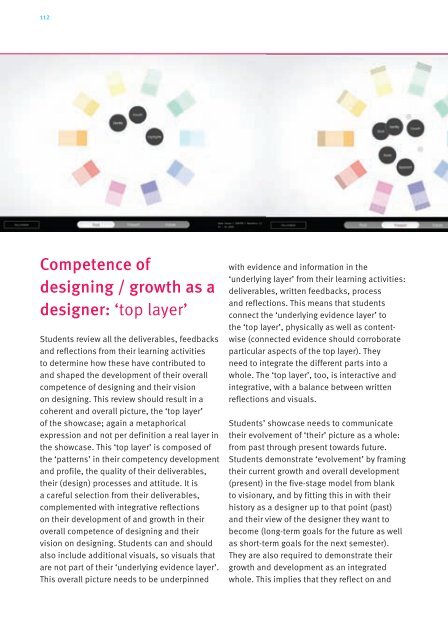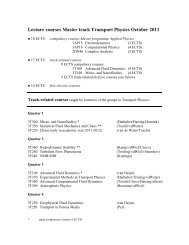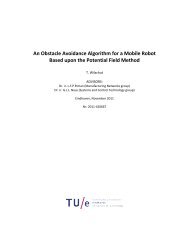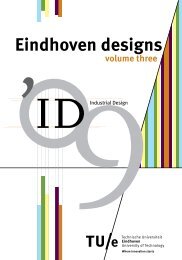Education guide 'Eindhoven designs' - Technische Universiteit ...
Education guide 'Eindhoven designs' - Technische Universiteit ...
Education guide 'Eindhoven designs' - Technische Universiteit ...
You also want an ePaper? Increase the reach of your titles
YUMPU automatically turns print PDFs into web optimized ePapers that Google loves.
112<br />
Competence of<br />
designing / growth as a<br />
designer: ‘top layer’<br />
Students review all the deliverables, feedbacks<br />
and reflections from their learning activities<br />
to determine how these have contributed to<br />
and shaped the development of their overall<br />
competence of designing and their vision<br />
on designing. This review should result in a<br />
coherent and overall picture, the ‘top layer’<br />
of the showcase; again a metaphorical<br />
expression and not per definition a real layer in<br />
the showcase. This ‘top layer’ is composed of<br />
the ‘patterns’ in their competency development<br />
and profile, the quality of their deliverables,<br />
their (design) processes and attitude. It is<br />
a careful selection from their deliverables,<br />
complemented with integrative reflections<br />
on their development of and growth in their<br />
overall competence of designing and their<br />
vision on designing. Students can and should<br />
also include additional visuals, so visuals that<br />
are not part of their ‘underlying evidence layer’.<br />
This overall picture needs to be underpinned<br />
with evidence and information in the<br />
‘underlying layer’ from their learning activities:<br />
deliverables, written feedbacks, process<br />
and reflections. This means that students<br />
connect the ‘underlying evidence layer’ to<br />
the ‘top layer’, physically as well as contentwise<br />
(connected evidence should corroborate<br />
particular aspects of the top layer). They<br />
need to integrate the different parts into a<br />
whole. The ‘top layer’, too, is interactive and<br />
integrative, with a balance between written<br />
reflections and visuals.<br />
Students’ showcase needs to communicate<br />
their evolvement of ‘their’ picture as a whole:<br />
from past through present towards future.<br />
Students demonstrate ‘evolvement’ by framing<br />
their current growth and overall development<br />
(present) in the five-stage model from blank<br />
to visionary, and by fitting this in with their<br />
history as a designer up to that point (past)<br />
and their view of the designer they want to<br />
become (long-term goals for the future as well<br />
as short-term goals for the next semester).<br />
They are also required to demonstrate their<br />
growth and development as an integrated<br />
whole. This implies that they reflect on and

















